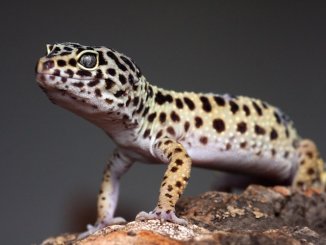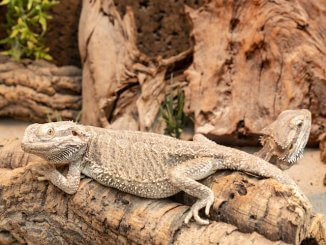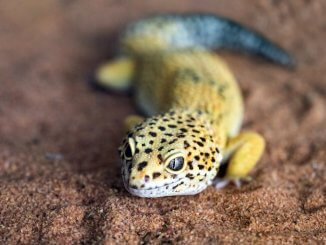Bearded dragons have over 10 unique behaviors. Some of the most common you are likely to see include head bobbing, glass surfing and waving.
It is not always easy to understand their wide range of behaviors and what they mean.
Some behaviors mean they are stressed or have health problems whilst others indicate aggression.
As a bearded dragon keeper it is important to know what each behavior means. It is also helpful to know which are normal and which are not.
If you want to learn about the ten most common bearded dragon behaviors and why they show these behaviors, then keep reading…

Ten Common Bearded Dragon Behaviors
When kept as pets Bearded dragons will show many different behaviors. Some are natural and are fun to watch. Others are rare and may be an indication of stress or illness. The important thing is to know what each behavior means and if you need to do anything.
1. Bearded Dragon Head Bobbing

Head bobbing is when your beardie moves their head quickly in an up and down movement.
This behavior is normal in pet and wild species.
It is very common for males to show this behavior. During breeding males will head bob to show their dominance to a female.
Males will bob their heads when performing a mating display to initiate courtship. Females show acceptance by bobbing their heads back.
Head bobbing can also be a form of aggression and dominance.
You may see head bobbing in your pet as they try to establish dominance in their tank.
In the wild bearded dragons have a large natural range. If they find another male in their territory they will head bob as a form of territorial aggression.
An individual declaring dominance will confront another with quick head nods. If the other bearded dragon chooses to submit, it will respond with slower head nods while arm waving. If an individual chooses not to submit the males will circle each other and fight. They will bite each other’s tails too.
2. Bearded Dragon Glass Surfing
Glass surfing happens when a bearded dragon tries to climb the glass in their enclosure. This behavior is not seen in the wild because beardies do not naturally encounter glass.
A bearded dragon with a darker beard will glass surf when stressed.
Normally the main cause of stress is their environment. It is common for first time keepers to make a mistake when setting up their tank. Some common examples include:
- Using a cage that is too small.
- Inadequate UVB lighting.
- Keeping more than one in an enclosure.
Glass surfing is a behavior that normally means stress.
This is not a natural behavior and you will need to pinpoint the cause of stress.
Using a larger enclosure and the correct lighting is very easy. If two beardies are sharing an enclosure then consider keeping them in separate tanks.
3. Bearded Dragon Digging

Digging is a very common and natural behavior. Some of the reasons bearded dragons dig include:
- Preparing to lay eggs.
- Stress.
- Looking for food.
- Not enough space.
- Preparing for brumation.
Gravid females will dig frantically in preparation to lay eggs.
Some individuals will dig because they are stressed. They are trying to hide or escape. Stress can be a result of incorrect lighting levels, heating, humidity and loud noises.
If your bearded dragon is not stressed but continues to dig, they may be underfed and are looking for food. Adult bearded dragons should weigh 380 to 510 grams. Monitor their diet closely to make sure they are receiving the right amount of food and nutrients.
You should only rule out underfeeding as the reason behind digging if they are a healthy weight.
Not having enough space to roam around can also result in boredom and digging.
Finally, bearded dragons dig to prepare for brumation. Brumation is a type of hibernation where beardies eat less and only drink water occasionally. Before brumation they will dig to find a safe and comfortable space to sleep. This space also helps to regulate their temperatures while they are hibernating. Brumation normally happens in the fall as light changes and temperatures drop.
4. Why Do Bearded Dragons Open Their Mouth?

Gaping is when a bearded dragon opens its mouth.
The most common reason for gaping is that your beardie is too hot. Beardies do not sweat like humans! Gaping is their only way of cooling down.
In the wild their habitat goes through extreme temperature changes.
Gaping is used as a cooling mechanism as they try to cool down and regulate their body temperature.
You will normally see them gape when basking.
The temperature in their basking area should be between 95 and 105°F.
Sometimes gaping is used by males to show dominance. However, it is normally used as a cooling mechanism. This is a natural behavior and is not a cause for concern.
If your pet is gaping a lot then check the position of your heat lamp. Make sure the heat lamp only covers half of the enclosure. It is important they have an area of shade to cool down. Having a heating lamp that covers the entirety of your beardie’s enclosure is dangerous.
5. Eye Bulging

When you look at a beardie during shed you may notice their eyes look like they are about to pop out of its sockets. This is known as eye bulging.
Eye bulging is common when your bearded dragon is shedding.
This is a normal behavior and it helps them to shed. It is nothing to worry about.
Bearded dragons will eye bulge to help loosen the skin around their eyes. This makes it easier for them to shed as their eyes and face is one of the toughest areas. If you want to help your reptile when they are shedding you can use baths, misting or a shedding aid.
Eye bulging is natural behavior.
As an owner there is not much you can do and it is important you let it run its course.
6. Bearded Dragon Arm Waving
Arm waving is known to be a form of submissive behavior. This behavior is common for hatchlings or juveniles and is less common in adults.
During their juvenile phase a social hierarchy based on feeding and aggression develops. Some species will become aggressive and dominant. Others are shier and more submissive.
Submissive bearded dragons will wave their arms towards more dominant individuals.
If you have two juveniles in the same enclosure it is not uncommon to the more submissive bearded dragon arm waving. They are trying to show they do not pose a threat. If you house multiple species together, and notice this behavior, then try giving them their own cage.
After their juvenile stage (over eight months old) you will find they do not wave their arms as much – especially males.
Bearded dragons in the wild also wave.
They normally wave their arms to show they have seen a predator or another bearded dragon species.
Arm waving helps to reduce the chance of them being attacked by a predator. This is because some of their predators (e.g. big cats) rely on ambushing as their main form of attack. Beardies showing predators they are aware of their presence takes away the ambush.
Though arm waving may seem like a friendly gesture, it is not.
7. Why Do Bearded Dragons Go Black?
Bearded dragons turn their beards’ black for many different reasons. The most common include when they feel threatened or stressed, want to breed or are sick. Males and females can turn their beards black, but it is more common in males.
This behavior is not a good sign for pet species.
It is important you understand why your bearded dragon has turned its beard black.
Your bearded dragon will turn it black when they feel threatened by a predator. A black beard paired with head bobbing is a sign of aggression.
A black beard can mean your reptile is ill.
If your beardie is ill, a black beard will be paired with other signs of illness such as lethargy, loss of appetite and swelling around the mouth.
Finally, if your bearded dragon wants to start breeding they may turn their beard black. This behavior is more common in wild species.
8. Why Do Bearded Dragons Flare Their Beard?

Fluffing is when a bearded dragon puffs up its beard to appear bigger. Both males and females fluff their beards as a defense mechanism. This behavior is normal and natural in bearded dragons. It is very common to see this behavior in wild species when they feel threatened.
A bearded dragon may also puff up its beard to challenge another species for territory. This can occur in wild and pet species.
Pets are more likely to show this behavior if they feel threatened by you.
If this happens you need to help your beardie adjust and become comfortable around you.
Occasionally you will see a pet beardie fluffing their beard – even if they do not feel threatened. This is normally a sign they are about to start shedding.
Bearded dragons fluff their beards before shedding to loosen the skin around their head.
9. Tail Twitching

In the wild bearded dragons twitch their tails when hunting for food.
You may see your pet do the same when hunting for insects in their tank.
Pet bearded dragons also twitch their tails when they are stressed during handling.
However, sometimes tail twitching can be a sign of metabolic bone disease.
The difference between normal tail twitching and one that indicates disease is that metabolic bone disease results in muscle spasms. You will see more of a tail spasm rather than controlled twitching.
10. Hissing and Stamping
When provoked or threatened a bearded dragon will show signs of aggression.
Bearded dragons hiss if they feel threatened or scared.
In the wild they hiss at predators to make themselves seem more threatening.
If your beardie hisses at you, then stop what you are doing. Hissing is a sign of aggression and is a behavior that prefaces biting.
It is normal for bearded dragons to hiss when they do not want to be disturbed. Normally this will be when they are shedding as it is uncomfortable for them.
Making your pet feel calm, unprovoked and safe will stop them hissing.
Many people also confuse stamping as a sign of aggression. However, males who are interested in females will stamp their feet on the ground. This is a natural behavior.
Bearded Dragon Behaviors Explained

Mating
Before mating bearded dragons will bob their heads. Their beard may go black too.
A black beard can show that a beardie is ready to mate. But, keep in mind that it can also mean they are stressed; this can be determined by the other behaviors that will follow if feeling threatened or ill.
Males head bob to initiate courtship and will continue this behavior during mating to show their dominance. Females accept a male’s gesture by head bobbing.
Shedding
When a bearded dragon sheds they will fluff, eye bulge and twitch their tails. All of these behaviors are done to make shedding easier:
- Eye bulging will help a beardie loosen the skin around its eyes.
- Beard fluffing helps to loosen the skin around the neck.
Keep in mind that shedding is uncomfortable.
It is important not to disturb them during this time. Avoid any handling and interactions. If you attempt to handle it is likely your beardie will twitch their tail and hiss.
Aggression
To show aggression bearded dragons will head bob, hiss, stamp and puff their beards.
Beardies in the wild hiss, stamp and fluff their beards to make themselves look bigger and more menacing. These behaviors help to ward off predators and keep them safe.
If they feel very threatened it is possible they will show all these behaviors.
It is always best to house bearded dragons alone. Keeping two individuals together can result in extreme aggressive and submissive behaviors.
When meeting new people they are more likely to head bob and fluff their beard.
Summary
| Behavior | Explanation |
|---|---|
| Arm Waving | Submissive behavior that is common in hatchlings and juveniles. |
| Head Bobbing | Used to initiate courtship and during mating or as a sign of aggression. |
| Glass Surfing | A sign of stress that is not seen in wild species. |
| Black Beard | Stress behavior when feeling threatened or ill. |
| Digging | A very common behavior when looking for food or preparing for brumation. |
| Fluffing | Used as a defense technique to protect their territory. |
| Gaping | Is used as a way of cooling down in the wild. |
| Tail Twitching | Normal when hunting but can be caused by metabolic bone disease. |
| Eye Bulge | This is a normal behavior and helps them to shed. |
| Hiss or Stamp | Bearded dragons hiss if they feel threatened or scared. |
Over the lifespan of your bearded dragon it is likely you will see at-least half of these behaviors.
Some of the most common behaviors include head bobbing, glass surfing and waving.
It is important you understand what each of these behaviors means as some can indicate stress or illness.
Have you seen your beardie wave or bulge their eyes before? How about gape or fluff their beards?
Let us know in the comments below.





Hi Mr. David, your article about breaded dragon behavior was so thorough and helpful. We have a 6 month old beardy named junior, we both love our bearded dragon. what is your opinion on heating lamps? I was recommended to use one.
Hi Shiran, you can see my suggested setup here.
Hello, I recently let my adult bearded male out for exercise and he walked over to my other tank which has juvenile beardies in it. One of the juveniles started puffing his entire body up and standing up, which I concluded he was posturing at the adult, however the other juvenile beardie just layed on their rock and didn’t move. Could this mean what I thought was 2 female beardies is in fact 1 female, one male? The adult surfed across the glass several times from the outside but didn’t appear to act aggressive. I’m wondering if the one who didn’t move is indeed female and the one acting aggressive is a male? Or is this just a territorial act?
I can help you add to your knowledge. Our Dragon, Bobby, glass surfs to let us know he needs to poop. Simple as that! We call it his ‘Poo Dance’ and everyone in our family responds to him, takes him outside. He sits on the grass, pancakes if it is a sunny morning (what we call the sunning behaviour), has a short run, poops, lifting his tail up and to the side to stay clean, has another short run, and then he’s done! He hasn’t done a poop in his enclosure since we worked this out. It’s great as his poops are stinky, LOL.
When we’re out and about or he’s being worn, he’ll let us know by becoming very wriggly that he needs to do a poo.
Hope this helps some others. We love our Bobby! He has a charmed existence. We live in Australia, I remember coming across bearded dragons in the wild when I was a kid. We have Blue Tongued Lizards in our yard here, one lives in a pipe and he’s called Huffy. We check on him and toss him the occasional treat. Probably a her actually, as she’s BIG.
Hello, i have had my breadie bakugou for about a year and like 4 months. he has his own 40-gallon tank (soon moving to a 75 gallon since he’s gotten so big so fast) and has no other animals around him. but what confuses me is that he has started to bob his head without anyone around other than me. is he trying to show dominance to me? or maybe he sees his reflection and thinks its another beardie?
Head-bobbing shouldn’t be worrisome. Your two hypotheses are definitely plausible, but it might also be an object you place in or near the enclosure which has a threatening aspect to your dragon. Keep in mind that head-bobbing is not only a show of dominance, since bearded dragon accepting another dragon’s dominance also bob their heads, although in a slower fashion. It is also part of the mating ritual.
Either way, try to move some objects, but most of all, give him time to get used to your presence, and understand that you are not a threat nor a competitor.